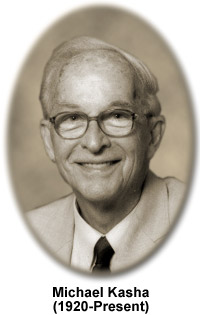Michael Kasha
(1920-Present)

Throughout the twentieth century, Michael Kasha has made numerous discoveries and contributions to the scientific world, greatly influencing the development of molecular electronic spectroscopy and molecular photochemistry. The son of Ukrainian immigrants, Kasha was born December 6, 1920 and raised in Elizabeth, New Jersey. He started his education at the University of Michigan, where he received his BS in chemistry in 1943, and finished at the University of California, which awarded him a PhD in 1945. While still at the University of California, Kasha coauthored two important papers on triplet states of organic molecules with the physical chemist Gilbert N. Lewis. Though initially their findings were received with considerable skepticism, the work eventually spawned a significant amount of interest in flash spectroscopy and Electron Paramagnetic Resonance (EPR) studies of the triplet state.
Following his graduation and Lewis’s death in 1946, Kasha spent several years carrying out postdoctoral research in Berkeley, California and Chicago, Illinois, as well as England. A fruitful time, his work concerning excited-state radiationless transitions resulted in what came to be known as Kasha’s Rules, which hold that the emitting state of a particular multiplicity is the lowest state in the assortment of excited states, and that the nonradiative states are typified by a diffuse band structure resulting from uncertainty broadening. His extensive research also demonstrated that a solvent containing heavy atoms could generate singlet-triplet transitions of organic molecules, a phenomenon eventually designated the Kasha effect.
In 1951, Kasha was offered a position as professor of physical chemistry at Florida State University, an institution that he has been associated with ever since. There he has influenced a tremendous number of students, several of which have gone on to establish prestigious careers in the sciences, founded the Institute of Molecular Biophysics, which is an interdisciplinary research establishment, as well as continued his own investigations in a number of arenas. Some of his most notable work involved applying molecular exciton theory to molecular aggregates, developing a vibrational deficiency theory for small symmetrical molecules, co-discovering the chemical production of singlet molecular oxygen, and investigating the electronic consequences of excited-state proton transfer.
Kasha has repeatedly been acknowledged and honored for his many scientific exploits. He was selected as a Fellow of the American Academy of Sciences in 1963 and elected a member of the National Academy of Sciences in 1971, becoming the first Floridian in both organizations. He was also appointed to the National Science Board by President Jimmy Carter in 1979, a post he held until 1984, and was made the Robert O. Lawton Distinguished Professor at Florida State University in 1962.
